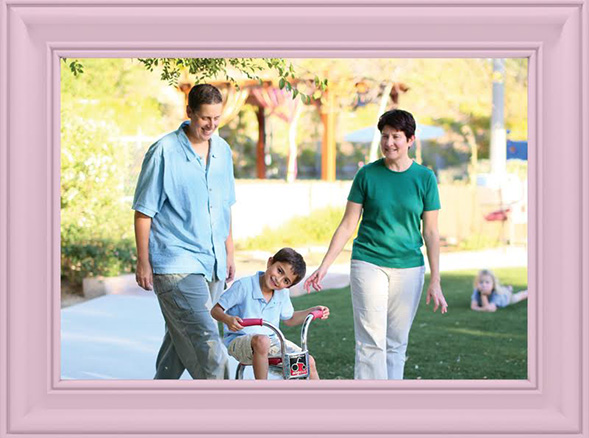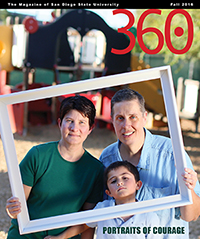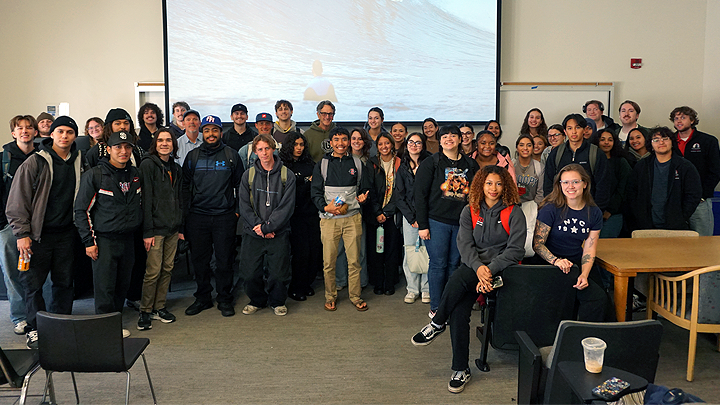Portraits of Courage: Heather Corliss
Heather Corliss is working to make the world of public health a more equitable place for all.

This is the first of four "Portraits of Courage," a series featuring courageous Aztecs who fight to make the world a better place for themselves, their families and their communities. The stories also appear in the fall 2016 issue of 360: The Magazine of San Diego State University.
There are potholes along the way to making the field of public health more equitable to all. Community invisibility, lack of knowledge, implicit bias and prejudice all perpetuate health inequalities.
These potholes manifest in different ways. They manifest in a community-based organization’s attempt to help transgender youth, but inability to understand what these young people say they need. They manifest in a well-intentioned public health professor who warns young people studying LGBT health issues that it will be difficult for them to have successful careers. They manifest in a health intervention theater program targeting at-risk youth where graduate students are warned, “Sometimes you get people in your program that you don’t want to be there, like for example, promiscuous gay boys who are all hitting on one other.”

Heather Corliss has seen these things and more over the course of her training and career as a researcher dedicated to eradicating health disparities in the LGBT community. She and her colleagues at San Diego State University have focused their careers on reducing minority health disparities and are working to pave a smoother road to better population health. For Corliss, it’s a personal experience, too, as she and her wife are raising a young son in a world filled with such potholes.
Corliss grew up in conservative rural Minnesota. She was always acutely aware of gender inequalities and decided early on she wanted do something to address them.
“I’ve always been motivated to make the world a better place and to make inequalities go away,” Corliss said.
She attended the University of Wisconsin–Madison and discovered an environment far more liberal and diverse than the one where she grew up. It was there she found “the space to learn more about myself.” She attended a talk by feminist activist Sonia Johnson and felt stirred by the speaker’s struggles supporting the Equal Rights Amendment. This was a time of activism for Corliss, who joined the student green party, and sought to deepen her understanding of social inequalities experienced by different minority groups. It was also in college that she came out to her parents about her sexuality.
A personal path
After her awakening experiences in Wisconsin, Corliss moved to San Francisco and found a job in HIV research at the University of California, San Francisco, studying the virus’s multitude of strains. She enjoyed the work, but wanted to help people in a more holistic way than focusing on a single disease.
“I didn’t start out thinking I wanted to study LGBT health, but that’s where my path took me,” Corliss said. “Experiences in my public health graduate training led me to believe that this was an area where I could make a positive difference,” she explained.
She moved from San Francisco to Los Angeles in 1997 and entered a graduate public health program at the University of California, Los Angeles. But even moving to relatively progressive L.A. was a culture shock.
“I had forgotten what the rest of the world was like.”
Some of her professors made disparaging comments about gay people. The community-based organizations she studied for a project on transgender youth health prioritized HIV prevention through condom usage. But through interviews with the youth, Corliss came to understand that condoms ranked pretty low on their list of priorities. Many needed basic resources for survival.
For example, they needed stable housing and they needed hormones to be able to align their physical presentation with their gender identity, both critical resources linked to a lower risk of violence.
“That was a transformative experience for me,” Corliss said. “I realized there was a disconnect between health professionals and the needs of the community they were trying to serve. I knew then I was where I wanted to be.”
Life changes
After earning her M.P.H., she started a Ph.D. program in epidemiology to learn how she could use population trends to spotlight areas of need in a community, as well as ways to direct resources toward those needs. As she finished her doctorate, two things happened: Corliss met Jennifer Thunstrom, who would become her wife, and she was offered a position as a postdoctoral fellow at Boston Children’s Hospital.
Thunstrom chose to accompany Corliss cross-country. While in Boston, Thunstrom returned to school to finish her bachelor’s degree and found a passion for anthropology. Corliss finished her postdoctoral fellowship and became an assistant professor at Harvard Medical School. The two lived happily in Boston for eight years.
After Corliss received a prestigious National Institutes of Health Career Development Award that afforded her greater job security, Corliss and Thunstrom felt the time was right to expand their family. Corliss had always wanted to have a child, and Thunstrom agreed to give it a go.
They chose to work with the Alternative Insemination Program at Fenway Community Health, a health center that specializes in LGBT health. Corliss subsequently became pregnant and their son, Connor, was born in 2010.
The first couple of years of parenthood were challenging in that Connor was born two months early and suffered a series of health complications. These challenges strengthened Corliss’ and Thunstrom’s resolve to make a better life for their family and their community. To that end, Thunstrom was motivated to apply to graduate programs in anthropology and was ultimately accepted into a Ph.D. program at the University of California, San Diego.
Then she showed Corliss a job announcement: SDSU’s Graduate School of Public Health was hiring. Corliss had been looking to incorporate more intervention research into her studies, and SDSU offered that opportunity. Their family moved to San Diego in 2013.
Common links
Over the past three years, Corliss has improved the quality and interdisciplinary nature of research in SDSU’s health research programs.
“Dr. Corliss’ presence at SDSU has helped me see that the work we are doing in Latino health disparities is relevant to other populations,” said Guadalupe X. “Suchi” Ayala, associate dean for research in the College of Health and Human Services.
“The effects of discrimination do similar things to our bodies, whether we are being discriminated against because of our sexual orientation or the color of our skin. Together, we are now trying to determine if the ways to reduce health disparities related to sexuality and ethnicity are similar.”
In her current role, Corliss hopes to deepen our understanding of the health disparities and concerns of subgroups across the range of sexual orientations and gender identities. She was the first to receive a large research grant from the National Institute of Diabetes and Digestive and Kidney Diseases to study lesbian and bisexual women’s disparities in the incidence of type 2 diabetes. Her research is finding that lesbian and bisexual women are more likely than heterosexual women to develop the disease. For this and other disparities, her ultimate goal is to develop interventions that can head off these health problems early.
“We tend to see a lot of negative health outcomes in younger LGBT people, but then these disparities lessen as they get older,” Corliss said. “A critical window for interventions is during adolescence and young adulthood. But we wouldn’t know that if we didn’t do this research.”



